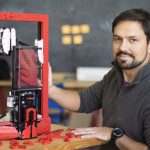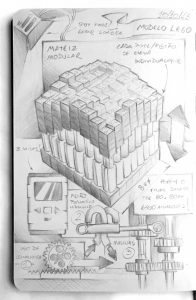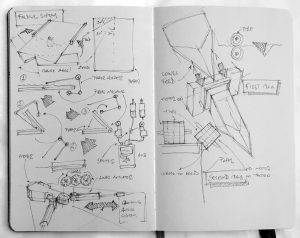
Arthur Sacek is a native of Sao Paulo, Brazil. He has a background in product design and has worked for Zoom Education for Life for many years. He is known for his amazing LEGO machines including a CNC machine and, most recently, a paper airplane launcher. He has turned his hobby of playing with LEGO into a career. He begins working for LEGO Education in Billund in August 2017.
How did you get started building with LEGO bricks?
My father used to give me LEGO sets for Christmas and birthdays, but my first contact with motorized sets was in high school. There was a robotics lab with some LEGO MINDSTORMS RCX and Control Lab sets. But, most of the time the lab was closed, so I asked the principal if I could use it with some friends.
With approval, we started to spend most of our afternoons in that place, building just for fun. It was awesome.
Which project (or projects) are you the most proud of? Why?
The Milling Machines. I spent only one week building the first version, but I had been dreaming for over a year before getting my hands on the bricks. The biggest challenge was the conversion of the 3D coordinates into the data that the NXT could read.
It was a huge surprise when I got the first object milled. I was not expecting so much precision.
Where do you find inspiration for new projects?

I like to watch sci-fi movies and get inspired by them. I can remember that I built the LEGO Pinpoint Animator because of the first X-Men movie in 2000. There is a scene where Wolverine, Storm and Cyclops stand beside a table that shows a 3D model of Liberty Island, New York. The project changed a lot from the this initial idea to the final product, but the basic concept was preserved.
Watch the video below to see the Pinpoint Animator.
How many iterations do you typically go through when you create your projects?
Several. I like to test new ideas, and usually they go wrong. So, to keep motivated, I try to follow these steps:
- Keep trying simple and small prototypes. It is important to spend the smallest amount of time, energy and LEGO elements in a test.
- Don’t accumulate a lot of ideas to test at once. It is going to be easier to analyze one idea at a time.
- Perseverance, if it is not working, take a break. Maybe you will find the solution in a different place and time.
“Don’t accumulate a lot of ideas to test at once. It is going to be easier to analyze one idea at a time.”
Do you document your creative process? If so, how and why?

When I get a new idea, I produce some sketches, and if I have time, I like to take pictures of the prototypes. When the final model is done, I make a video and upload it to my YouTube channel.
But it doesn’t happen every time. I regret not taking photos of some old projects during the development process.
In 2015, I had a great opportunity developing a commissioned project, the LEGO Paper Plane Machine. It was a TV commercial for Arrow Electronics and the production team filmed the behind-the-scenes.
What role does failure have in your creative process?
The truth is that failure happens every time, and it is not the best feeling. But I learnt that if I want to develop new things, failure will be part of my day-to-day. It is important to expect failure and be prepared to analyze the results.
How do you evaluate your success?
I like to dream about the project before any kind of development action. Normally, it takes several days, and in this period, I determine my objectives and collect a lot of references.
By the end of the project I compare the result with the initial concept. If they are similar, I will be very happy. If they are different, something went wrong with maybe the concept or maybe the final product… But I will still be happy because you always learn something new.
For students who are ready to go beyond the basics, what project would you recommend to get them motivated, without overwhelming them?
Look for a day-by-day task that could be done by a robot. Probably, your robot will need to interact with other objects and materials (power switch, cup, pencil…). It is a good building challenge.
After your first design is complete, simplify your model. Try to take elements off and leave just the essentials. In the building process, it is common to use more elements than you really need. It will help you to get a better design with more elegant solutions.
“After your first design is complete, simplify your model. Try to take elements off and leave just the essentials.”
What’s your favourite LEGO piece?
I love the cross block family. These elements are awesome because they can support several building orientations. It is the kind of element that you with always find in my models.

To see more of Arthur’s work, visit his webpage and YouTube Channel.
Also in Meet the Creator
- Meet the Creator: Kristal Dubois
- Meet the Creator: Arthur Sacek
- Meet the Creator: Jason Allemann
Asha
Latest posts by Asha (see all)
- Meet the Creator: Akiyuki Kawaguchi - 29 May 2018
- Meet the Creator: Paweł “Sariel” Kmieć - 25 April 2018
- Reflections on Vassilis Chryssanthakopoulos - 27 March 2018
- Meet the Creator: Lee Magpili - 27 February 2018
- Meet the Creator: Anton Vanhoucke - 16 November 2017


